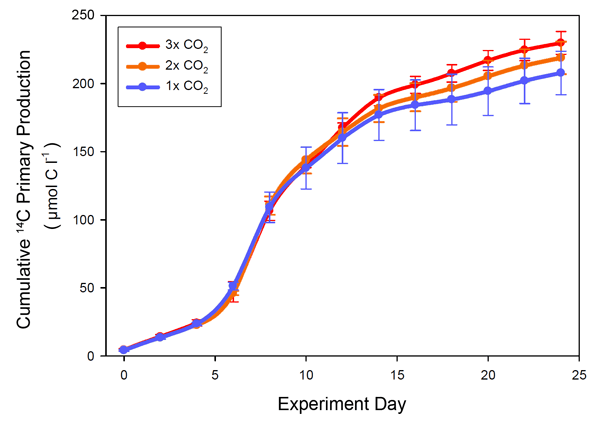Reference
Egge, J.K, Thingstad, T.F., Larsen, A., Engel, A., Wohlers, J., Bellerby, R.G.J. and Riebesell, U. 2009. Primary production during nutrient-induced blooms at elevated CO2 concentrations. Biogeosciences 6: 877-885.
Background
Three oceanic CO2-enrichment experiments (I, II and III) were carried out in 2001, 2003 and 2005 at the Marine Biological Station of the University of Bergen at Espegrend, Norway, where nine marine ecosystems were maintained within two-meter-diameter polyethylene bags submerged to a depth of ten meters in an adjacent fjord, three of which mesocosms were maintained at ambient levels of CO2 (1xCO2), while three others were maintained at 2xCO2 and three more at 3xCO2 (via aeration of the water column and the overlying atmosphere with CO2-enriched air), all of which was done within the context of the Pelagic Ecosystem CO2 Enrichment (PeECE) program, which enabled the conducting of the PeECE I, PeECE II and PeECE III experiments.
What was done
After a one-time addition of nutrients that were intended to initiate a phytoplankton bloom on the day prior to the start of their 24-day study, Egge et al. measured primary production in the nine mesocosms at two-day intervals during the PeECE III experiment, along with oxygen production and consumption, the presence of transparent exopolymer particles, and the composition of the phytoplanktonic community.
What was learned
The seven scientists report that "in the second half of the experiment there was a tendency of higher production at elevated CO2 levels," which was "visible from ca. day 10 in the cumulative production, with a significant difference between 3x and 1x CO2 from day 20 onward," as shown in the figure below.

Cumulative primary production from the start of the PeECE III experiment of Egge et al. (2009), adapted from the authors' paper.
What it means
Egge et al. say their results "demonstrate a small, but statistically significant effect of elevated CO2 on daily primary production" that is "consistent with the over-consumption of dissolved inorganic carbon at elevated CO2 reported by Riebesell et al. (2007) and Bellerby et al. (2008)." These observations once again suggest that the planet's rising atmospheric CO2 concentration may well stimulate oceanic primary production and thereby enable the sustaining of a greater population of higher-trophic-level marine organisms, many of which could ultimately end up on our dinner tables.
References
Bellerby, R.G.J., Schulz, K.G., Riebesell, U., Neil, C., Nondal, G., Johannessen, T. and Brown, K.R. 2008. Marine ecosystem community carbon and nutrient uptake stoichiometry under varying ocean acidification during the PeECE III experiment. Biogeosciences 5: 1517-1527.
Riebesell, U., Schulz, K., Bellerby, R., Botros, M., Fritsche, P., Meyerhofer, M., Neill, C., Nondal, G., Oschlies, A., Wohlers, J. and Zollner, E. 2007. Enhanced biological carbon consumption in a high CO2 ocean. Nature 450: 545-548.
Reviewed 9 September 2009



